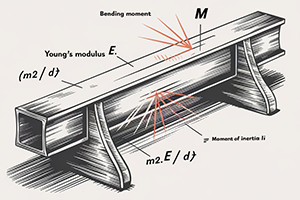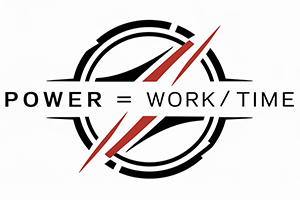Strain Energy in Beams Calculator

Diagram of the beam with bending moment distribution.
You're calculating the strain energy stored in a beam due to bending. The beam is subjected to various loads, and you want to determine the total strain energy.
Calculation:
The strain energy \( U \) stored in a beam is given by:
U = ∫0L (M2 / 2EI) dxWhere:
U = Strain Energy M = Bending Moment E = Modulus of Elasticity I = Moment of Inertia L = Length of the beam dx = Infinitesimal length elementDaily Life Uses of Strain Energy in Beams Formula
Example 1: Bridge Design
When designing a bridge, engineers calculate the strain energy in beams to ensure that the structure can bear the weight of vehicles and pedestrians. By applying the formula U = ∫0L (M2 / 2EI) dx, they evaluate the maximum bending moment (M) and how much energy the beams can absorb before yielding.
For a bridge beam with a length of L = 10 meters, a bending moment M = 500 Nm, a Young’s modulus E = 200 GPa, and a moment of inertia I = 0.005 m4, the strain energy can be calculated using the formula U = ∫0L (M2 / 2EI) dx.
Substituting values: U = (5002 / 2 × 200 × 109 × 0.005) × 10 = 0.125 Joules.
Example 2: Skyscraper Construction
In skyscraper construction, strain energy calculations using the formula U = ∫0L (M2 / 2EI) dx help determine the maximum load-bearing capacity of floor beams, ensuring that the building can sustain both static loads (e.g., walls) and dynamic loads (e.g., wind).
A skyscraper beam with L = 8 meters, M = 1000 Nm, E = 250 GPa, and I = 0.01 m4 would store strain energy calculated as:
U = (10002 / 2 × 250 × 109 × 0.01) × 8 = 0.16 Joules.
Example 3: Crane Design
In crane operations, the formula U = ∫0L (M2 / 2EI) dx is used to assess the energy storage in lifting beams when carrying heavy loads. It ensures that the beams do not reach their elastic limit and undergo plastic deformation during operation.
A crane arm with a beam of length L = 12 meters, moment M = 1500 Nm, modulus E = 210 GPa, and moment of inertia I = 0.003 m4 would have strain energy:
U = (15002 / 2 × 210 × 109 × 0.003) × 12 = 0.214 Joules.
Example 4: Aircraft Wing Design
The formula U = ∫0L (M2 / 2EI) dx is used in the design of aircraft wings to calculate how much strain energy the wings can store under aerodynamic loading. This helps in ensuring that the wings do not bend excessively under the load during flight.
For an aircraft wing with L = 15 meters, moment M = 2500 Nm, modulus E = 190 GPa, and moment of inertia I = 0.004 m4, the strain energy is:
U = (25002 / 2 × 190 × 109 × 0.004) × 15 = 0.493 Joules.
Example 5: Building Earthquake Resistance
In earthquake-prone areas, engineers apply the strain energy formula U = ∫0L (M2 / 2EI) dx to assess the amount of energy beams in the building can absorb during seismic activity. This helps ensure the building can flex without breaking, improving its resilience to earthquakes.
In a building designed to resist earthquakes, for a beam with L = 5 meters, M = 800 Nm, E = 300 GPa, and I = 0.002 m4, the strain energy is calculated as:
U = (8002 / 2 × 300 × 109 × 0.002) × 5 = 0.053 Joules.
Strain Energy in Beams - Frequently Asked Questions (FAQs)
1. What is strain energy in beams?
Strain energy in beams refers to the energy stored in a beam due to its deformation under load. It is calculated using the formula U = ∫(M² / 2EI) dx, where M is the bending moment, E is Young's modulus, I is the moment of inertia, and L is the length of the beam.
2. What are the components of the strain energy formula?
The components of the strain energy formula are:
- M - Bending moment
- E - Young’s modulus of the material
- I - Moment of inertia
- L - Length of the beam
3. How is the strain energy used in beam design?
Strain energy is used in beam design to determine how much energy a beam can store under loading conditions before it experiences permanent deformation or failure. Engineers use this to design beams that are both safe and efficient for structural purposes.
4. Why is Young's modulus important in strain energy calculations?
Young's modulus (E) measures a material’s stiffness. It plays a crucial role in strain energy calculations because stiffer materials store less energy for the same deformation compared to more flexible materials.
5. How does bending moment affect strain energy?
The bending moment (M) directly affects strain energy. A larger bending moment results in more strain energy being stored in the beam as it causes greater deformation under loading.
6. Can strain energy in beams be recovered?
Strain energy can be partially recovered if the beam is in the elastic range. However, if the beam is deformed beyond its elastic limit, some of the energy is lost as permanent deformation (plastic deformation).
7. What is the significance of moment of inertia (I) in the strain energy formula?
The moment of inertia (I) measures the beam’s resistance to bending. A higher moment of inertia reduces the strain energy stored in the beam for the same bending moment, making it more resistant to deformation.
8. How does the length of the beam (L) affect strain energy?
The length of the beam (L) affects the total strain energy, as the formula integrates along the length of the beam. A longer beam generally stores more strain energy under the same load compared to a shorter one.
9. In what type of structures is strain energy considered critical?
Strain energy is critical in structures like bridges, skyscrapers, aircraft wings, and earthquake-resistant buildings. These structures undergo significant deformation, and proper calculation of strain energy ensures their safety and performance under loading conditions.
10. How can strain energy lead to beam failure?
If a beam stores too much strain energy, it can reach its elastic limit and experience permanent deformation or failure. Understanding strain energy helps engineers design beams that avoid such failures under expected loads.

 Pneumatic-Hydraulic
Pneumatic-Hydraulic  Materials-Weight
Materials-Weight
 Miscellaneous Cal's
Miscellaneous Cal's Mechanics
Mechanics